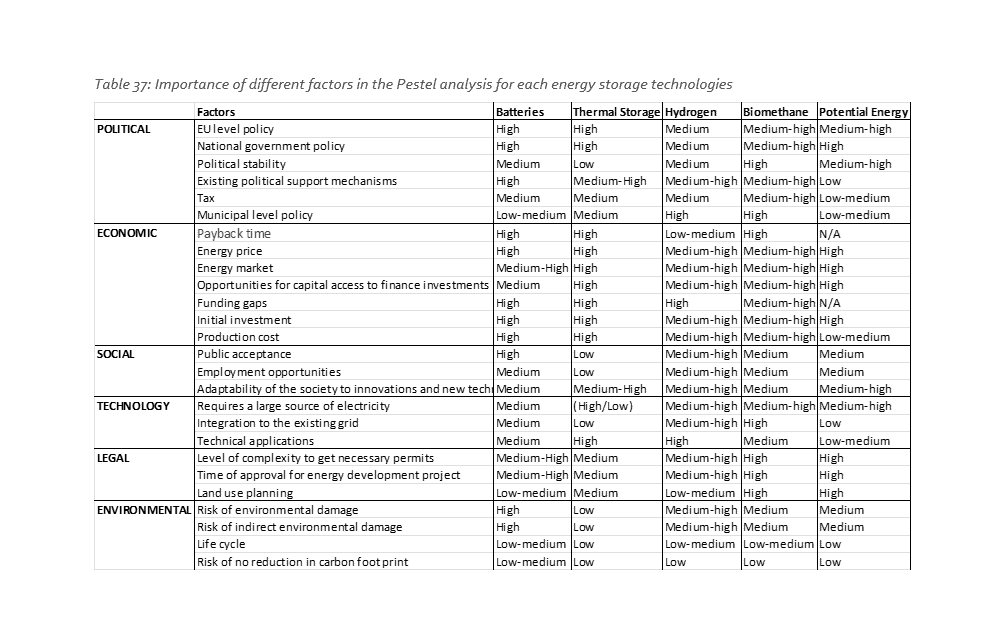
Municipal Energy Storage: A Comprehensive 6 Month Progress Report and Analysis
18 September 2023
We’re thrilled to present the initial progress report of our project, summarizing the first six months of project implementation results. During this period, Energy Equilibrium project partners conducted extensive research on diverse energy storage solutions and created a comprehensive “Outlook on multidimensional KPIs of a carbon-neutral energy system in municipalities.” Additionally, project’s first deliverable developed concise technology summaries for various energy storage options, conducted in-depth PESTLE analyses, and performed cross-country comparisons of political, economic, technological, legal, social, and environmental factors influencing energy storage deployment in municipalities.
Five energy storage alternatives were considered: batteries for electricity storage, thermal energy storage, energy storage in a form of hydrogen and biomethane, and pumped hydro energy storage.
Highlights of the report
In recent years, energy storage technologies have seen varying levels of acceptance. Battery storage has gained widespread recognition for its efficiency and eco-friendliness, despite facing challenges like limited energy density, battery life, and grid integration. Power-to-heat and thermal energy storage systems’ acceptance hinges on factors like efficiency, costs, flexibility, and environmental impact, but challenges such as heat losses and integration persist. Hydrogen and biomethane, with its environmental benefits and versatility, is gaining popularity as an energy source, but hurdles like infrastructure and production costs remain. Nonetheless, hydrogen is expected to have a significant role in the future energy landscape as technology advances and infrastructure grows.
A total of six countries underwent PESTLE analysis on energy storage deployment factors in municipalities, including Latvia, Finland, Sweden, Lithuania, Poland, and Germany.
Battery storage technologies
Advantages:
- Clean Energy: Batteries offer a clean alternative to traditional energy storage methods like diesel generators. They store surplus energy and release it when required, reducing reliance on fossil fuels and cutting greenhouse gas emissions.
- Grid Stability: Battery storage helps stabilize power grids and reduces the need for grid expansion. It stores excess renewable energy and releases it when demand peaks, optimizing the use of the electricity grid and minimizing reliance on conventional power plants.
- Cost Savings: The cost of battery storage has significantly dropped due to technological advancements, economies of scale, and improved production techniques. This affordability has made battery storage more accessible and widely used.
- Energy Independence: Battery storage empowers households and businesses to rely less on external energy sources. It allows them to store surplus energy for later use, which is particularly advantageous in regions with unreliable power supplies or high electricity costs.
- Financial Support: Various governments and energy companies offer incentives like subsidies and tax breaks to promote battery storage adoption. These funding policies have played a crucial role in encouraging the deployment of battery storage solutions.
Challenges:
- Energy Capacity Limitations: Batteries have limited energy capacity, restricting their ability to store large amounts of energy for extended periods. Developing batteries with higher energy density and capacity is crucial to overcome this limitation.
- Battery Lifespan and Performance: Batteries degrade over time, affecting their capacity and performance. Prolonging battery life and maintaining high performance are essential for the economic viability of battery storage solutions.
- Environmental Sustainability: Battery production often involves materials like lithium, cobalt, and nickel, which can harm the environment during extraction and disposal. Developing sustainable methods for material extraction and disposal is imperative.
- Grid Integration Complexity: Seamlessly integrating battery storage into the power grid is a technical challenge. Advanced control systems and communication technologies are needed to efficiently operate batteries and ensure grid stability.
- Scalability Issues: While battery storage is deployed on a small scale, scaling up to larger systems poses challenges in terms of capacity, location selection, grid connection, and infrastructure development. Coordination and planning are crucial for successful large-scale battery integration.
Thermal energy storage
Advantages:
- Energy Efficiency: Power-to-heat systems efficiently utilize excess electrical energy that would otherwise go to waste, improving overall energy efficiency. This promotes the use of renewable energy sources and generally leads to positive acceptance.
- Cost Considerations: The cost-effectiveness of power-to-heat systems is a significant factor in their acceptance. High construction and operational costs compared to other heat generation or storage methods can deter adoption. However, state subsidies and incentive programs can alleviate cost concerns and boost acceptance.
- Grid Flexibility: Power-to-heat systems enhance power grid flexibility by absorbing surplus electricity during periods of high renewable energy generation. This reduces strain on the grid during overload situations. Acceptance depends on energy supply companies’ willingness to integrate flexible loads and make necessary grid adjustments.
- Environmental Impact: Power-to-heat systems contribute to reducing greenhouse gas emissions, especially when powered by renewable energy sources. This environmentally friendly aspect can drive adoption as it aligns with green energy objectives.
- Regulatory Framework: A favorable regulatory environment can significantly influence the acceptance of power-to-heat systems. Clear and stable legislation, along with incentive mechanisms, can encourage investments in these systems and thereby increase their acceptance.
Challenges:
- Heat Losses: Thermal energy storage systems experience heat losses due to heat transfer and thermal radiation. These losses increase over time, especially in long-term storage scenarios. Minimizing heat loss involves using materials with low thermal conductivity and effective insulation.
- Limited Storage Capacity: Heat storage tanks have finite capacity, making it challenging to store large quantities of thermal energy over extended periods, such as for seasonal storage needs.
- Choice of Storage Medium: Selecting the right storage medium is crucial for efficiency and reliability. Different materials have varying heat capacities and properties that impact storage performance. The chosen medium should also be cost-effective and environmentally friendly.
- Cycle Stability: Thermal accumulators operate in cycles, storing and releasing thermal energy repeatedly. This cyclic operation can affect the longevity and performance of the storage system. Materials and components must be designed to withstand these cycles for long-term, reliable operation.
- Integration with Energy Systems: Integrating thermal storage systems into existing energy systems can be complex. It requires precise control and regulation to align thermal energy storage with system demands. Additionally, storage tanks must harmonize with other energy system components, including heat generators and consumers.
Accumulation in the form of hydrogen
Advantages:
- Environmental Friendliness: Hydrogen can be produced and burned without emitting harmful pollutants. Its combustion only results in water vapor, making it a clean energy source that doesn’t contribute to greenhouse gases or air pollution. When generated using renewable energy, hydrogen can play a crucial role in decarbonizing the energy system.
- Versatile Applications: Hydrogen has diverse applications across various sectors, including transportation, power generation, industrial processes, and residential use. It can be used as a vehicle fuel, a means of storing renewable energy, and a raw material in the chemical industry.
- Energy Storage: Hydrogen serves as an effective energy storage solution, particularly for renewable energy sources like solar and wind power. Surplus energy can be used to convert water into hydrogen, which can then be converted back into energy when demand arises.
Challenges:
- Infrastructure: Hydrogen infrastructure, including filling stations, pipelines, and storage facilities, is currently limited and requires substantial development. Creating a comprehensive hydrogen infrastructure demands significant investments and time.
- Cost: Hydrogen production, especially from renewable sources, remains relatively expensive. Cost reduction is essential to enhance the competitiveness of hydrogen as an energy source.
- Safety: Hydrogen is highly flammable, leading to safety concerns. Strict adherence to safety standards and regulations is crucial to ensure safe handling and utilization.
Accumulation in the form of biomethane
Aspects to consider:
- Renewable Energy Integration: Methanation can be a way to store renewable hydrogen and use it as an energy carrier, aiding the integration of renewable energy sources like wind and solar power. It’s discussed as a potential solution to decarbonize the energy system.
- Efficiency and Energy Loss: Methanation involves energy losses, as energy is required for the process. The efficiency of methanation is crucial for acceptability, especially when the hydrogen comes from renewables. Energy losses and the overall process energy balance should be considered.
- Infrastructure and Market Development: Existing methane distribution infrastructure can be leveraged for methanation, enhancing acceptability, especially in regions with established gas infrastructure.
- Technology Development and Cost: Methanation technology is still developing, and cost is a significant factor. Reducing the cost of hydrogen methanation compared to alternative storage options can boost its adoption.
- Environmental Impact: Methanation produces methane, a potential greenhouse gas. Managing methane emissions is vital to minimize environmental impact and ensure that methanation contributes to reducing greenhouse gas emissions.
Accumulation in the form of potential energy
Aspects to consider:
- Energy Demands and Security: Regions with high energy demands and concerns about energy security often view pumped storage plants as vital infrastructure to meet energy needs and ensure a stable energy supply.
- Environmental Impact: Pumped storage plants can impact the environment, particularly concerning water balance and landscapes. Building dams and reservoirs may disrupt ecosystems, alter natural flow patterns, and raise concerns about habitat loss and fish migration.
- Landscape and Tourism: In areas heavily reliant on tourism or where natural beauty is significant, concerns about landscape integration and visitor appeal may arise due to the substantial scale of pumped storage plant structures.
- Local Community Impact: The direct impact on the local community affected by a pumped storage plant is important. This encompasses issues like land expropriation, community relocation, and effects on local economies. Acceptance depends on community consultation, involvement, and potential compensatory measures.
- Renewable Energy and Climate Protection: Pumped storage plants are crucial for integrating renewable energy sources like wind and solar power and enhancing grid flexibility. Regions prioritizing renewable energy expansion and climate protection often view pumped storage plants positively.
In the PESTLE analysis, political and economic factors hold the most significance for mature technologies like battery and thermal energy storage, with a focus on economic viability influenced by political support, energy costs, and investment requirements. On the other hand, emerging technologies such as hydrogen, biomethane, face regulatory and licensing challenges, coupled with ongoing technological advancements.
Find out more about the report here.
To acquire additional information, track the project’s progress and results on the official website at https://interreg-baltic.eu/project/energy-equilibrium-interreg-baltic-sea/.
This article was prepared and published by Laura Kristiāna Vičmane
© Photo by Shutterstock.






